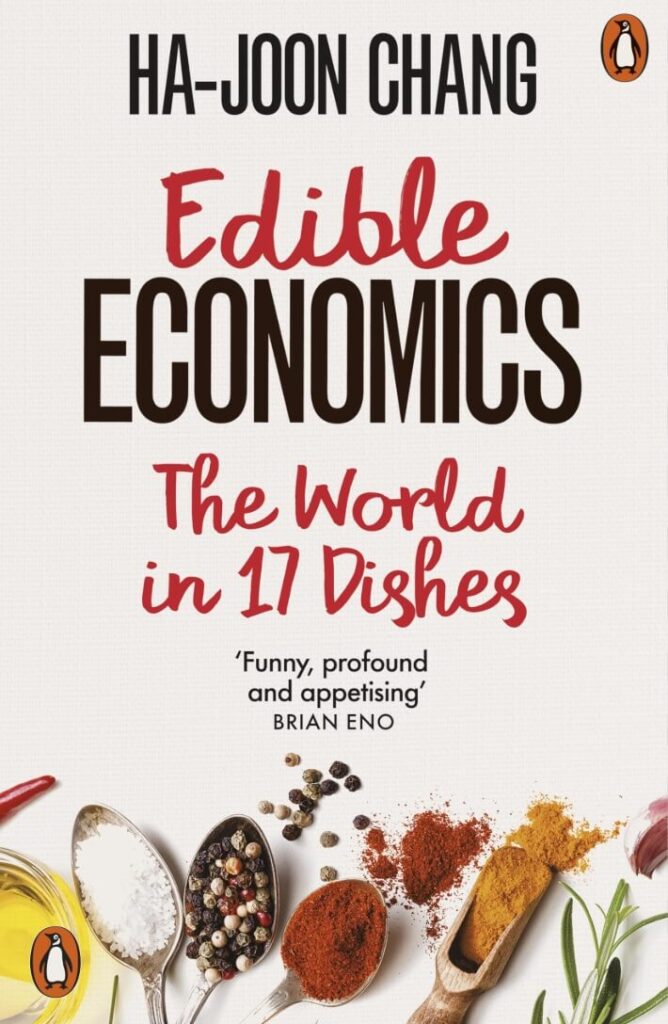What do chocolate, tofu, instant noodles, and bananas have to do with economic development, inequality, or globalization? In Edible Economics: A Hungry Economist Explains the World, Ha-Joon Chang serves up a surprisingly tasty answer.
Blending food writing with economics, Chang has created a book unlike any other. It’s part cookbook for the brain, part political manifesto, and part cultural commentary — all rooted in the idea that food is more than just sustenance. It’s a window into history, identity, and the systems that shape our world.
If you’ve ever been intimidated by economics or bored by its dry presentation, this book is a delightful entry point. It’s fun, accessible, and as nourishing intellectually as your favorite comfort food.
💡 Why This Book Feels Fresh (and Timely)
Published in 2022, Edible Economics arrived in the wake of a pandemic, a global food crisis, and rising inflation — when the cost of living, food security, and economic justice became dinner table issues around the world.
Chang responds by bringing economics to the dinner table — quite literally. Using food as a metaphor and teaching tool, he makes complex ideas intuitive and memorable. But don’t be fooled by the playful premise: this is serious economics, served creatively.
🧠 The Core Idea
Each chapter in Edible Economics is anchored by a specific food item, from chocolate and garlic to oysters and coffee. Chang then connects that food to a major economic concept or historical insight. The result is a series of essays that are equal parts culinary trivia, social history, and policy analysis.
Here are just a few pairings that stand out:
⦁ Instant Noodles & Industrial Policy:
A symbol of modern convenience, instant noodles become a jumping-off point to discuss how government planning helped countries like South Korea industrialize rapidly — contrary to free-market dogma.
⦁ Bananas & Globalization:
Behind this cheap, familiar fruit lies a history of colonialism, exploitation, and multinational corporate power. Chang unpacks how trade and development are rarely fair or neutral.
⦁ Tofu & Economic Identity:
Tofu, a humble staple, represents how cultural perception shapes economic value — much like how economists assign value to different kinds of work.
⦁ Garlic & Economic Stereotypes:
Garlic’s divisive reputation in different cultures parallels how economic myths — like the “lazy South” versus the “efficient North” — shape policy and prejudice.
Chang doesn’t just teach you economics — he helps you taste it, smell it, and feel it.
📚 Structure of the Book
The book is made up of roughly 20 short chapters, each about 8–10 pages, making it ideal for bite-sized reading. Each chapter includes:
⦁ A short history or cultural profile of a food item
⦁ An explanation of an economic idea, framed through that food
⦁ Real-world examples and a critical perspective on mainstream thinking
The tone is conversational, often humorous, and always clear — perfect for readers new to economics or those tired of textbook jargon.
✅ Why You Should Read This Book
It’s a Brilliant Way to Learn Economics
Most economics books demand that you meet them on technical ground. Edible Economics comes to you — through your kitchen, your culture, and your everyday experience.
It Humanizes Policy and Theory
Chang uses food to show that economics isn’t just numbers and charts — it’s about people, culture, emotion, and justice. What we grow, buy, and eat is shaped by deeper forces of power and inequality.
It Reframes Familiar Ideas
By turning economic theories into stories about chocolate or lentils, Chang makes abstract ideas memorable. You won’t forget his critiques of neoliberalism once they’re tied to your morning cup of coffee.
🎯 Real-World Relevance
This book offers more than clever metaphors — it’s a timely critique of the modern global economy. Chang touches on urgent topics such as:
⦁ Supply chains and food security: COVID-19 and war have exposed the fragility of global trade.
⦁ Inflation and inequality: Rising prices hit the poor hardest — especially for essentials like food.
⦁ Agricultural subsidies and climate change: Chang explores how farming policies in rich countries distort global markets and hurt developing nations.
⦁ Cultural economics and identity: The story of food becomes a story of how we value labor, tradition, and innovation.
In short, this book shows how what’s on your plate is linked to what’s happening on Wall Street, in Brussels, or at the WTO.
⚠️ Where the Book May Challenge You
It’s Not a Textbook
If you’re looking for formal economic models or deep dives into technical debates, this isn’t the place. It’s more about conceptual reframing than mathematical analysis — though grounded in serious thought.
It’s Politically Charged
As with Chang’s other books, Edible Economics takes aim at neoliberalism and economic orthodoxy. If you’re attached to the idea that free markets always know best, expect some spicy pushback.
💬 What Readers and Critics Say
“A feast of ideas” — Critics have praised the book for its originality, saying it’s both intellectually satisfying and fun to read.
“Food for thought, literally” — Many readers appreciate how the book makes complex economic issues relatable, especially for younger readers and non-specialists.
“Chang’s most creative work yet” — Longtime fans of the author see this as his most accessible and emotionally resonant book — one that connects the head and the heart.
📈 Final Verdict: ★★★★☆ (4.5/5)
Edible Economics is a rich, inventive, and deeply humane book that transforms the way we think about both food and finance. By weaving together economics, culture, and cuisine, Ha-Joon Chang creates a reading experience that is as nourishing as it is enlightening.
This isn’t just a book for economists or foodies. It’s for anyone who wants to understand the forces shaping our world — and how those forces show up in our grocery bills, dinner tables, and national debates.
Whether you read it cover to cover or savor it chapter by chapter, Edible Economics will leave you with a fuller understanding of the world — and maybe a deeper appreciation for the next meal you eat.




